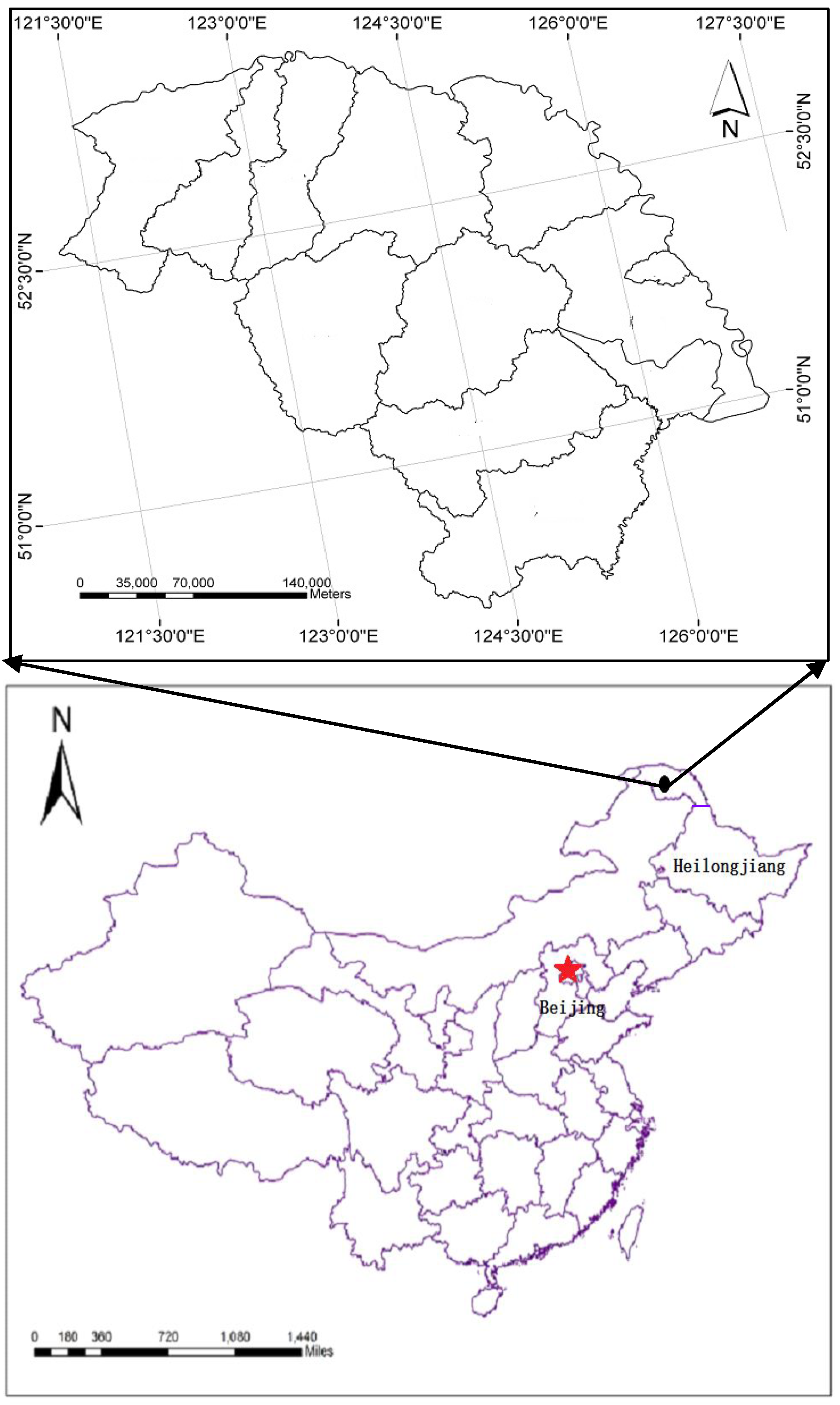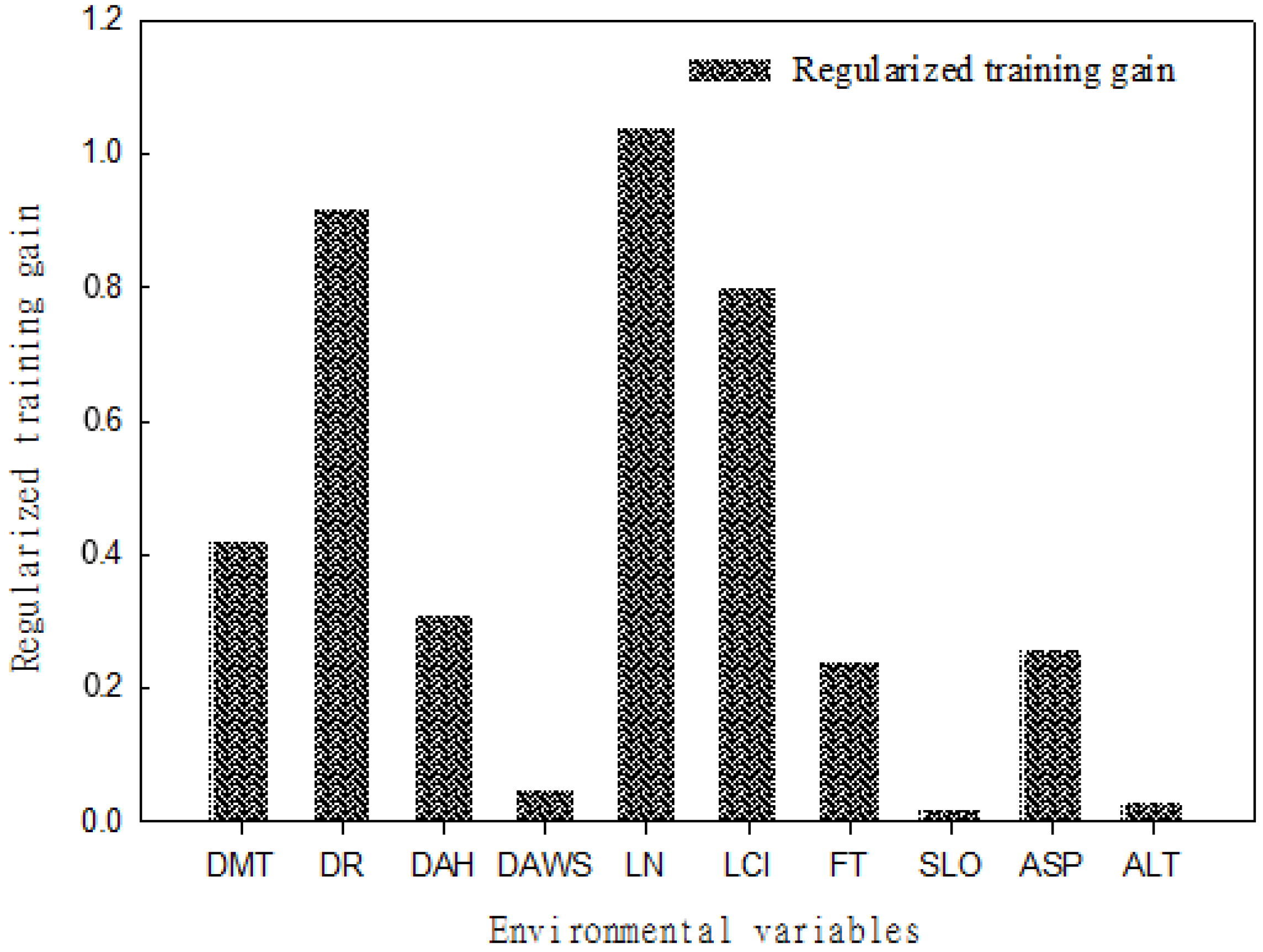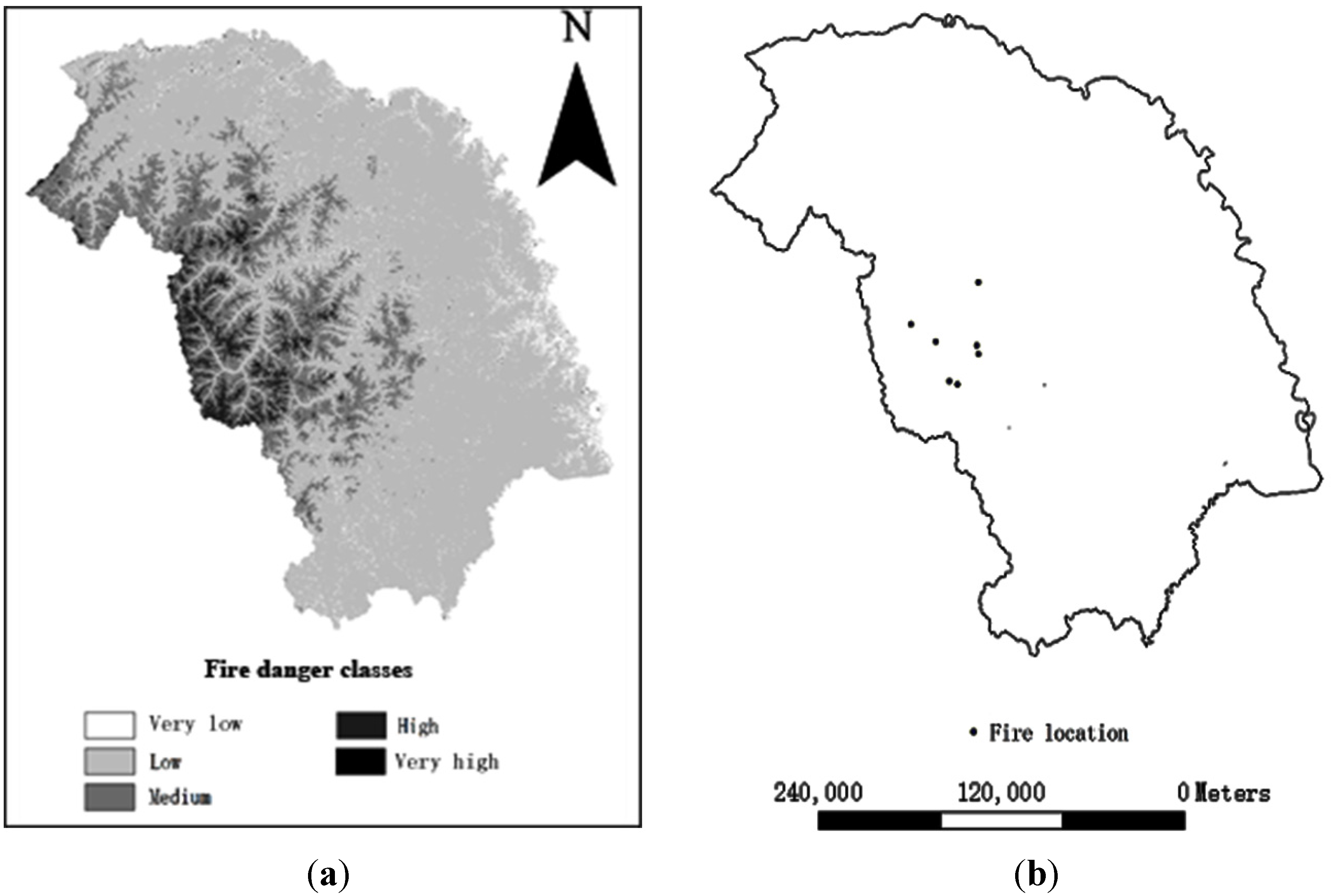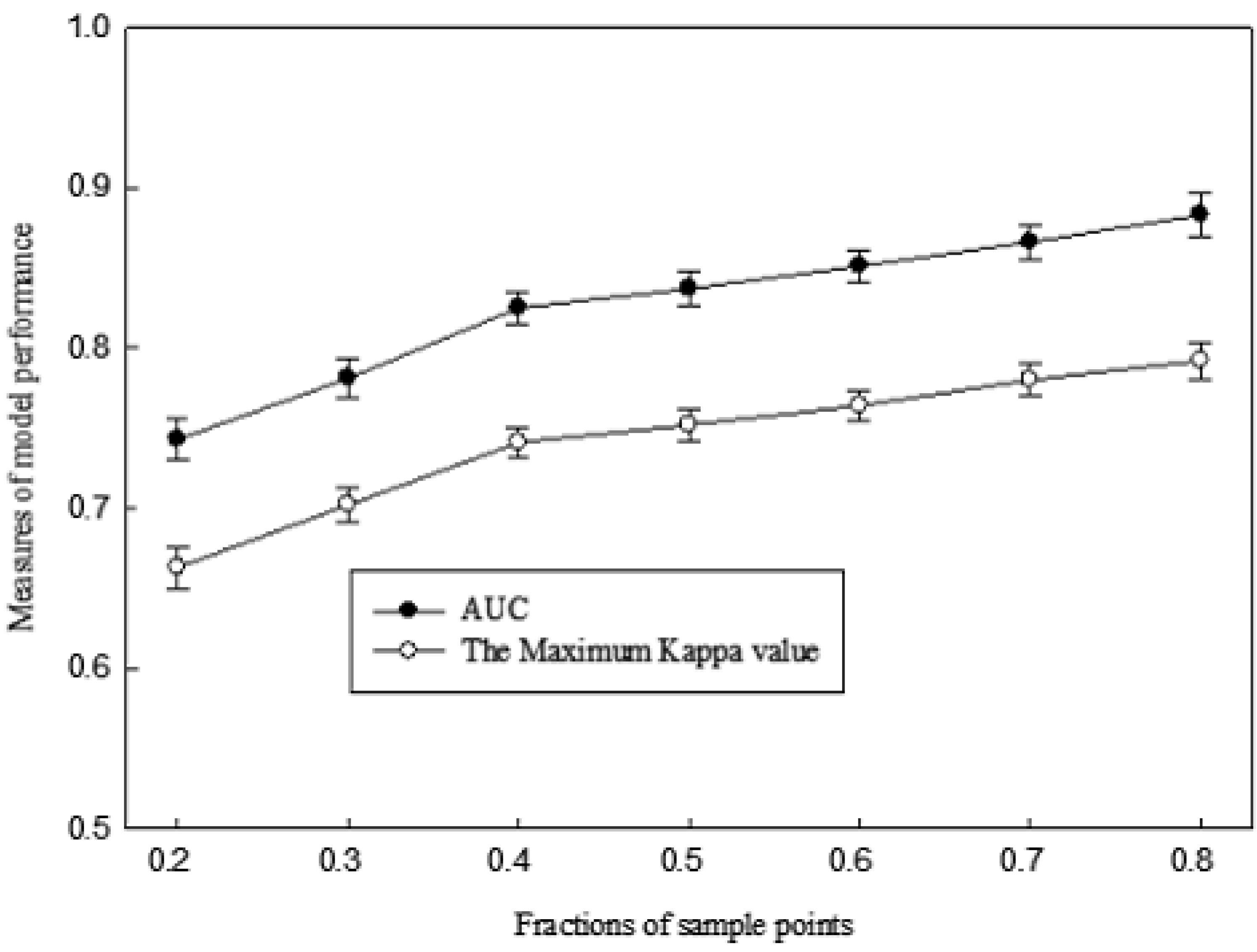Modeling Forest Lightning Fire Occurrence in the Daxinganling Mountains of Northeastern China with MAXENT
Abstract
:1. Introduction
2. Materials and Methods
2.1. Study Areas
2.2. Data Resources

2.3. Data Preparation and Variable Selection
| Variable Type | Variable Code | Description | Unit |
|---|---|---|---|
| meteorological factor | DMT | Daily average maximum temperature in the 3 days before the ignition | °C |
| DR | Rainfall in the 3 days before the ignition | mm | |
| DAH | Daily average relative humidity in the 3 days before the ignition | % | |
| DAWS | Daily average wind speed in the 3 days before the ignition | m/s | |
| Lightning | LN | Number of strikes on the day of the ignition | |
| LCI | Lightning current intensity for all strikes | A | |
| NC | Neutralized charge amount for all strikes | C | |
| LE | Lightning energy for all strikes | J | |
| Fuel | FT | Forest fuel type of ignition | categorical |
| Topography | ALT | Altitude | m |
| SLO | Slope | ||
| ASP | Aspect | % |
2.4. Maxent Modelling of Fire Occurrences
2.5. Contribution of Environmental Variables
2.6. Model Evaluation
| Predicted | Observed | |
|---|---|---|
| Presence | Absence | |
| Presence | true positive | false positive |
| Absence | false negative | true negative |
| Indicator | Formula |
|---|---|
| Overall accuracy | (a+d)/n |
| True positive rate (sensitivity) | a/(a+c) |
| False positive rate | b/(b+d) |
| True negative rate (specificity) | d/(b+d) |
| False negative rate | c/(a+c) |
| Kappa statistic |
2.7. Sample Size
3. Results
3.1. Multi-Collinearity Relations between Environmental Variables
| Eigenvalue of the Correlation Matrix | Proportion of Variation | |||||||||||
|---|---|---|---|---|---|---|---|---|---|---|---|---|
| DMT | DAH | DAWS | DR | FT | ALT | ASP | SLO | LCI | LN | LE | NC | |
| 7.9109 | 0.0009 | 0.0003 | 0.0021 | 0.0018 | 0.0040 | 0.0021 | 0.0026 | 0.0034 | 0.0029 | 0.0017 | 0.0034 | 0.0041 |
| 1.2141 | 0.0015 | 0.0004 | 0.0003 | 0.0879 | 0.0045 | 0.0001 | 0.0265 | 0.0019 | 0.0142 | 0.0691 | 0.0019 | 0.0009 |
| 0.4866 | 0.0009 | 0.0008 | 0.0013 | 0.0158 | 0.2986 | 0.0002 | 0.0632 | 0.2489 | 0.0332 | 0.0031 | 0.2489 | 0.1024 |
| 0.3721 | 0.0070 | 0.0006 | 0.0592 | 0.0849 | 0.1518 | 0.0346 | 0.0147 | 0.3160 | 0.0207 | 0.0285 | 0.0160 | 0.1160 |
| 0.2961 | 0.0006 | 0.0000 | 0.0000 | 0.0701 | 0.4884 | 0.0356 | 0.0629 | 0.0110 | 0.2739 | 0.0652 | 0.0110 | 0.1240 |
| 0.2386 | 0.0047 | 0.0002 | 0.0815 | 0.2360 | 0.0163 | 0.0526 | 0.4088 | 0.0107 | 0.1538 | 0.0187 | 0.0107 | 0.0136 |
| 0.1722 | 0.0025 | 0.0001 | 0.3634 | 0.1452 | 0.0184 | 0.0016 | 0.0734 | 0.0391 | 0.2179 | 0.3864 | 0.0391 | 0.0362 |
| 0.1392 | 0.0776 | 0.0313 | 0.2372 | 0.1332 | 0.0004 | 0.0003 | 0.0100 | 0.0889 | 0.1297 | 0.1600 | 0.0889 | 0.0089 |
| 0.1148 | 0.0035 | 0.0006 | 0.0405 | 0.0027 | 0.0033 | 0.8566 | 0.3194 | 0.2663 | 0.1412 | 0.0208 | 0.5663 | 0.5361 |
| 0.0467 | 0.8403 | 0.1031 | 0.0012 | 0.0576 | 0.0001 | 0.0137 | 0.0169 | 0.0138 | 0.0117 | 0.2459 | 0.0138 | 0.0246 |
| 0.0088 | 0.0605 | 0.8626 | 0.2134 | 0.1649 | 0.0141 | 0.0025 | 0.0014 | 0.0000 | 0.0009 | 0.0006 | 0.0000 | 0.0000 |
| VIF | 1.9530 | 1.7850 | 1.1860 | 2.0630 | 1.2540 | 1.1480 | 1.5340 | 1.7900 | 1.3220 | 2.6440 | 5.0120 | 6.2310 |
3.2. Variables Contribution to the Predicted Model


3.3. Model Fit

3.4. Effect of Sample Size on Model Predictions

4. Discussion
4.1. Factors Influencing Performance of the Predicted Model
4.2. Environmental Determinants of Lightning Fire Occurrence
4.3. Practical Insights for Fire Management
5. Conclusions
Acknowledgments
Author Contributions
Conflicts of Interest
References
- Renard, Q.; Pélissier, R.; Ramesh, B.R.; Kodandapani, N. Environmental susceptibility model for predicting forest fire occurrence in the Western Ghats of India. Int. J. Wildland Fire 2012, 21, 368–379. [Google Scholar] [CrossRef]
- Shu, L.F.; Wang, M.Y.; Tian, X.R.; Li, Z.Q.; Xiao, Y.J. Fire environment mechanism of lightning fire ccurrence in Daxinganling region, China. Sci. Silv. Sin. 2009, 22, 18–24. [Google Scholar]
- Lei, X.L.; Zhou, G.S.; Jia, B.R.; Li, S. Relationships of forest fire with lightning in Daxinganling Mountains, Northeast China. Chin. J. Appl. Ecol. 2012, 23, 15–22. [Google Scholar]
- Podur, J.; Martell, D.L.; Csillag, F. Spatial atterns of lightning-caused forest fires in Ontario, 1976–1998. Ecol. Model. 2003, 164, 1–20. [Google Scholar] [CrossRef]
- Wotton, B.M.; Martell, D.L. A lightning fire occurrence model for Ontario. Can. J. For. Res. 2005, 35, 1389–1401. [Google Scholar] [CrossRef]
- Du, C.Y.; Li, S.; Liu, D.; Li, X.F.; Yu, C.L. Spatiotemporal distribution of lightning-caused forest fires in Daxinganling area. J. Nat. Disaster 2010, 19, 74–78. [Google Scholar]
- Vankat, J.L. General patterns of lightning ignitions in Sequoia National Park, California. In Proceedings of the Symposium and Workshop in Wilderness Fires, Missoula, Montana, 15–18 November 1983; Lotan, J.E., Kilgore, B.M., Fischer, W.C., Mutch, R.W., Eds.; USDA Forest Service, Intermountain Forest and Range Experiment Station: Fort Collins, CO, USA, 1983; pp. 408–411. [Google Scholar]
- Fuquay, D.M.; Baughman, R.G.; Taylor, A.R.; Hawe, R.G. Characteristics of seven lightning discharges that caused forest fire. J. Geophys. Res. 1967, 72, 6371–6373. [Google Scholar] [CrossRef]
- Fuquay, D.M.; Taylor, A.R.; Hawe, R.G.; Schmid, C.W. Lightning discharges that caused forest fires. J. Geophys. Res. 1972, 77, 2156–2158. [Google Scholar] [CrossRef]
- Fuquay, D.M.; Baughman, R.G.; Latham, D.J. A Model for Predicting Lightning Fire Ignitions in Wildlands Fuels; USDA Forest Service research Paper INT–217: Ogden, UT, USA, 1979. [Google Scholar]
- Krider, E.P.; Noggle, R.C.; Uman, M.A. A gated, wideband magnetic direction finder for lightning return strokes. J. Appl. Meteorol. 1976, 15, 301–306. [Google Scholar]
- Kourtz, P.H.; Todd, J.B. Predicting the Daily Occurrence of Lightning Caused Forest Fires; Information Report PI-X-112; Forestry Canada, Petawawa National Forestry Institute: Petawawa, Canada, 1992. [Google Scholar]
- Burrows, W.R. Dynamical-statistical models for lightning prediction to 48-hr over Canada and the United States. In Proceedings of the 20th Lightning Detection Conference, Tucson, AZ, USA, 21–23 April 2008.
- Miller, A.J. Least squares routines to supplement those of gentleman. J. Roy. Statist. Soc. 1992, 41, 458–478. [Google Scholar]
- Andserson, K. A model to predict lightning-caused fire occurrences. Int. J. Wildland Fire 2002, 11, 163–172. [Google Scholar] [CrossRef]
- Vilar, L.; Nieto, H.; Martin, M.P. Integration of lightning- and human-caused wildfire occurrence models. Hum. Ecol. Risk Assess 2010, 16, 340–364. [Google Scholar] [CrossRef]
- Castedo-Dorado, F.; Rodriguez-Perez, J.R.; Marcos-Menendez, J.L.; Alvarez-Taboada, M.F. Modelling the probability of lightning-induced forest fire occurrence in the province of Leon (NW Spain). For. Syst. 2011, 20, 95–107. [Google Scholar]
- Magnussen, S.; Taylor, S.W. Prediction of daily lightning- and human-caused fires in British Columbia. Int. J. Wildland Fire 2012, 21, 342–356. [Google Scholar] [CrossRef]
- Krenn, R.; Hergarten, S. Cellular automaton modelling of lightning-induced and manmade forest fires. Nat. Hazards Earth Syst. Sci. 2009, 9, 1743–1748. [Google Scholar] [CrossRef]
- Dickson, B.G.; Prather, J.W.; Xu, Y.; Hampton, H.M.; Aumack, E.N.; Sisk, T.D. Mapping the probability of large fire occurrence in northern Arizona, USA. Landsc. Ecol. 2006, 21, 747–761. [Google Scholar] [CrossRef]
- Albert-Green, A.; Dean, C.B.; Martell, D.L.; Woolford, D.G. A methodology for investigating trends in changes in the timing of the fire season with applications to lightning-caused forest fires in Alberta and Ontario, Canada. Can. J. For.Res. 2013, 43, 39–45. [Google Scholar] [CrossRef]
- Guo, F.T.; Hu, H.Q.; Jin, S.; Ma, Z.H.; Zhang, Y. Relationship between forest lightning fire occurrence and weather factors in Daxinganling Mountains based on negative binomial model and zero-inflated negative binomial models. Chin. J. Plant. Ecol. 2010, 26, 87–92. [Google Scholar]
- Deblauwe, V.; Barbier, N.; Couteron, P.; Lejeune, O.; Bogaert, J. The global biogeography of semi-arid periodic vegetation patterns. Glob. Ecol. Biogeogr. 2008, 17, 715–723. [Google Scholar] [CrossRef]
- Phillips, S.J.; Anderson, R.P.; Schapire, R.E. Maximum entropy modeling of species geographic distributions. Ecol. Model. 2006, 190, 231–259. [Google Scholar] [CrossRef]
- Elith, J.; Phillips, S.J.; Hastie, T.; Dudík, M.; Chee, Y.E.; Yates, C.J. A statistical explanation of Maxent for ecologists. Divers. Distrib. 2011, 17, 43–57. [Google Scholar] [CrossRef]
- Chuvieco, E. Wildland Fire Danger Estimation and Mapping: The Role of Remote Sensing Data; World Scientific: River Edge, NJ, USA, 2003. [Google Scholar]
- Pyne, S.J.; Andrews, P.L.; Laven, R.D. Introduction to Wildland Fire, 2nd ed.; John Wiley and Sons: New York, USA, 1996. [Google Scholar]
- Parisien, M.A.; Moritz, M.A. Environmental controls on the distribution of wildfire at multiple spatial scales. Ecol. Monogr. 2009, 79, 127–154. [Google Scholar] [CrossRef]
- Thornton, P.E.; Running, S.W.; White, M.A. Generating surfaces of daily meteorological variables over large regions of complex terrain. J. Hydrol. 1997, 190, 214–251. [Google Scholar] [CrossRef]
- Flannigan, M.D.; Wotton, B.M. Lightning-ignited forest fires in northwestern Ontario. Can. J. For. Res. 1991, 21, 277–287. [Google Scholar] [CrossRef]
- Williams, E. Lightning and forest fires. In Forest Fires, Behavior and Ecological Effects; Johnson, E.A., Miyanishi, K, Eds.; Academic Press: San Diego, CA, USA, 2001; pp. 375–418. [Google Scholar]
- Guisan, A.; Zimmermann, N.E. Predictive habitat distribution models in ecology. Ecol. Model. 2000, 135, 147–186. [Google Scholar] [CrossRef]
- Phillips, S.J.; Dudik, M. Modeling of species distributions with Maxent: New extensions and a comprehensive evaluation. Ecography 2008, 31, 161–175. [Google Scholar] [CrossRef]
- Phillips, S.J. A Brief Tutorial on Maxent; AT&TLabs-Research: Florham Park, NJ, USA, 2005. [Google Scholar]
- Elith, J.; Graham, C.H.; Anderson, R.P.; Dudik, M.; Ferrier, S.; Guisan, A.; Hijmans, R.J.; Huettmann, F.; Leathwick, J.R.; Lehmann, A.; et al. Novel methods improve prediction of species’ distributions from occurrence data. Ecography 2006, 29, 129–151. [Google Scholar] [CrossRef]
- Landis, J.R.; Koch, G.C. The measurement of observer agreement for categorical data. Biometrics 1977, 33, 159–174. [Google Scholar] [CrossRef]
- Hosmer, D.; Lemeshow, S. Applied Logistic Regression; Wiley-Interscience: New York, NY, USA, 2000; p. 392. [Google Scholar]
- Hall, B.L. Precipitation associated with lightning ignited wildfires in Arizona and New Mexico. Int. J. Wildland Fire 2007, 16, 242–254. [Google Scholar]
- Rorig, M.L.; Mckay, S.J.; Ferguson, S.A.; Werth, P. Model-generated predictions of dry thunderstorm potential. J. App. Meteorol. Clim. 2007, 46, 605–614. [Google Scholar] [CrossRef]
- Larjavaara, M.; Pennanen, J.; Tuomi, T.J. Lightning that ignites forest fires in Finland. Agric. For. Meteorol. 2005, 132, 171–180. [Google Scholar] [CrossRef]
- Shindo, T.; Uman, M.A. Continuing current in negative cloud-to-ground lightning. J. Geophys. Res. Atmos. 1989, 94, 5189–5198. [Google Scholar] [CrossRef]
- De Vasconcelos, M.J.P.; Silva, S.; Tome, M.; Alvim, M.; Pereira, J.C. Spatial prediction of fire ignition probabilities: Comparing logistic regression and neural networks. Photogramm. Eng. Remote Sens. 2001, 67, 73–81. [Google Scholar]
- Conedera, M.; Cesti, G.; Pezzatti, G.B.; Zumbrunnent, T.; Spinedi, F. Lightning-induced fires in the Alpine region: An increasing problem. For. Ecol. Manag. 2006, 234, S68. [Google Scholar]
- Wierzchowski, J.; Heathcott, M.; Flannigan, M.D. Lightning and lightning fire, central cordillera, Canada. Int. J. Wildland Fire 2002, 11, 41–51. [Google Scholar] [CrossRef]
© 2015 by the authors; licensee MDPI, Basel, Switzerland. This article is an open access article distributed under the terms and conditions of the Creative Commons Attribution license (http://creativecommons.org/licenses/by/4.0/).
Share and Cite
Chen, F.; Du, Y.; Niu, S.; Zhao, J. Modeling Forest Lightning Fire Occurrence in the Daxinganling Mountains of Northeastern China with MAXENT. Forests 2015, 6, 1422-1438. https://doi.org/10.3390/f6051422
Chen F, Du Y, Niu S, Zhao J. Modeling Forest Lightning Fire Occurrence in the Daxinganling Mountains of Northeastern China with MAXENT. Forests. 2015; 6(5):1422-1438. https://doi.org/10.3390/f6051422
Chicago/Turabian StyleChen, Feng, Yongsheng Du, Shukui Niu, and Jinlong Zhao. 2015. "Modeling Forest Lightning Fire Occurrence in the Daxinganling Mountains of Northeastern China with MAXENT" Forests 6, no. 5: 1422-1438. https://doi.org/10.3390/f6051422





